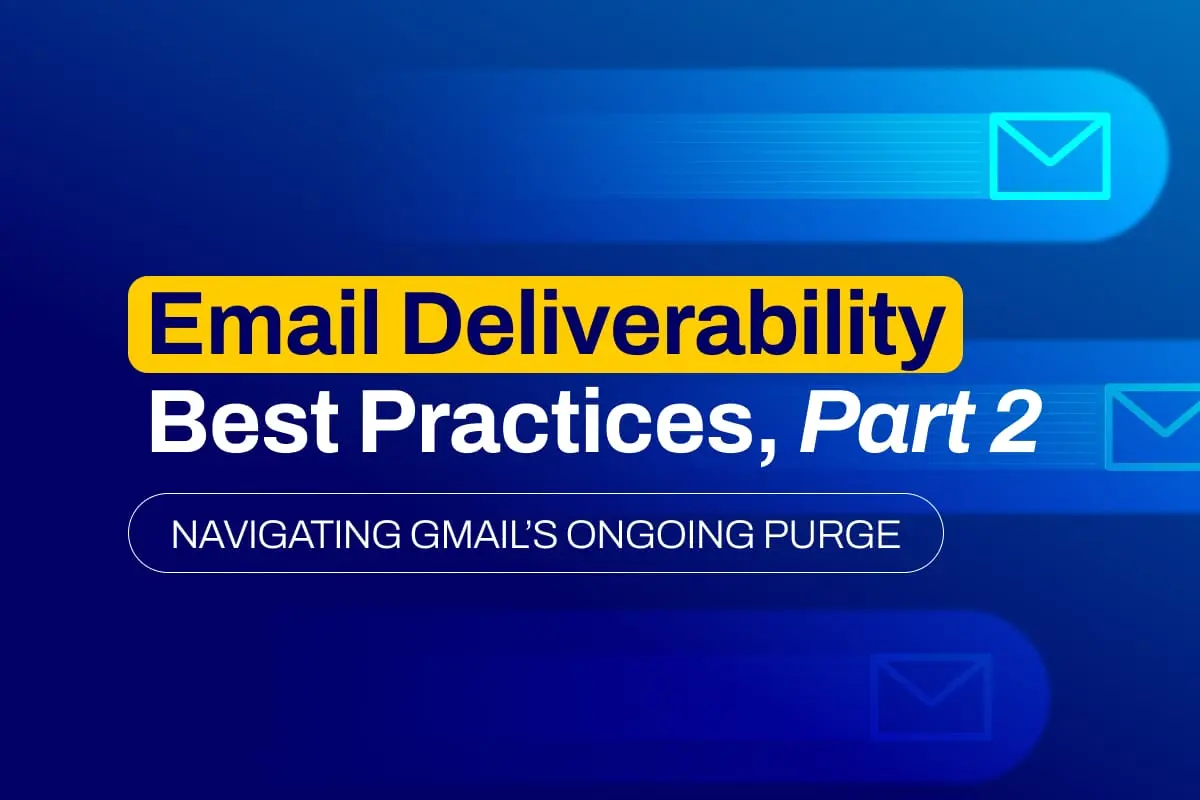
Email Deliverability Best Practices Marketing Cloud, Part 2 DESelect | Best Salesforce Solutions
What Is the Effect on Email Marketers?
An erasure of inactive Gmail accounts could mean many of your emails won’t be delivered if your contact list is outdated. Attempting to send a message to nonexistent addresses will result in a hard bounce. Sending to inactive addresses and inactive subscribers can also cause deliverability issues, as these contacts are common sources of bounces and reduced engagement. If left uncorrected, too many hard bounces result in a negative impact to your email sender reputation, which causes email service providers (ESPs) to flag the sender’s entire domain. Once this happens, it’s not uncommon to find your messages skipping the inbox and going straight to spam.
What Is Email Sender Reputation?
In a way, your reputation defines if people will talk to you or not- much like high school. Your email sender reputation is set by ESPs and determines whether emails sent by each domain will actually be delivered to the desired recipient. Domain reputation is also a critical factor in email deliverability, as it reflects the trustworthiness of your sending domain and works alongside IP reputation. In other words, a low score indicates that the sender might be a spammer, leading to their emails being delivered straight to the spam box. Needless to say, it is a big deal to email marketers if subscribers can’t even find your communications.
When scoring your sender reputation, ESPs analyze sender history (too many emails sent in a short period are a red flag, since they want to protect recipients from spammers), sender score (a metric that reflects your overall sending reputation and impacts inbox placement), level of engagement (open and click-through rates, which are influenced by subscriber behavior such as how recipients interact with your emails), unsubscribe rates, spam complaints, and bounce rates, which is why it is important to adhere to email deliverability best practices.
A high bounce rate might indicate that the mailer is either not managing its contact list properly or has purchased a mailing list – a big no-no in the eyes of email service providers. Therefore, even if your org has organically built a mailing list, a high bounce rate caused by messaging nonexistent accounts will definitely lower your email sender reputation score.

Mitigating the Damage
This “purge,” despite its dramatic impact, does not present irremediable consequences to organizations that take the appropriate responses. Email marketers can preserve their sender reputation by simply updating and cleaning their mailing lists. Free tools such as Zero Bounce or Validity Inc.’s BriteVerify can flag any invalid email addresses in your contact. These email validation services identify typos in email addresses, accounts that have marked you as spam, spam traps, and most importantly, invalid addresses. Additionally, ensure your email domain is properly configured and authenticated to maximize deliverability and build trust with recipient servers.
You should take advantage of these tools or more manual processes in Marketing Cloud (more on that later) to prevent increased bounce rates and optimized email marketing ROI, but that might not be enough.
Further email deliverability best practices to maintain a positive sender reputation include:
- Implementing proper email authentication protocols such as SPF, DKIM, and DMARC to verify your emails and enhance brand trust.
- Including an unsubscribe link in every email to comply with legal requirements and reduce spam complaints.
1. Avoid spam trigger words
Email service providers have several means at their disposal to protect their users. One that marketers should keep in mind is their list of words that most commonly trigger spam filters. Refrain from using terms that might be classified as clickbait, such as “free” (unless, of course, you are in fact offering something of value for free). Any other words that make a message seem too good to be true are also on the chopping block. Spam trigger words lower the credibility of your email and signal to email service providers that your content is of a quality fit for the spam box. There are great resources online that can help marketers find the perfect balance when it comes to email communications and avoid spam complaints, such as Inbox Monster’s Monster Guide to Sending Frequency.
2. Organically grow contact lists
While buying a previously established contact list might be the most convenient and quick option to grow a database, it can seriously damage your sender reputation. When recipients who are on a purchased mailing list receive your email, they are much less likely to open your message because they did not even want to receive it in the first place!
For email service providers, extremely low open and click rates are a dead giveaway that recipients have no interest in receiving your emails.
Instead, organizations should organically create and nurture their contact lists, focusing on engaged subscribers who have shown recent interest through opens or clicks. This email deliverability best practice can best be achieved by offering incentives to new subscribers, such as an informative ebook or an enticing promotional offer. Make sure to utilize all the resources at your disposal to expand your subscriber list, such as your organization’s social media channels and blog. Additionally, always respect subscriber preferences to improve engagement and deliverability.
Additionally, it is good practice to send out personalized offers based on consumer behavior—using personalized content tailored to individual subscribers increases engagement. According to a research conducted by Sheer ID and Kelton Global, 94% of consumers are more likely to take action when receiving a personalized offer
Personalization also contributes to Word of Mouth marketing, as subscribers who receive content that is relevant to them will be more likely to encourage others to join the mailing list. Last but not least, try out A/B testing to ensure that the messages being sent out are the most optimal. You can measure the performance of subject lines, content, design, or even more substantial elements such as offers and discounts by analyzing how users engage with different versions to optimize results.
3. Utilizing double opt-in
“Double opt-in” is the process of sending a confirmation email to subscribers once they have signed up for a newsletter. Many times, users will register their emails just to gain access to some form of gated content and do not have any intentions to receive future emails. By utilizing double opt-in, marketers become certain their mailing lists are filled with only individuals who are truly interested in what they have to say.
In light of Gmail’s purge, a confirmation email might be sent to all low-engagement contacts as a way to double-check your recipients’ interest. If they do not answer, their accounts are inactive or they are no longer interested in receiving your emails. Either way, your contact list is better off without them.
The bottom line – subscribers who hard bounce should be removed from your mailing list. Just like Google deleted irrelevant emails, brands need to proactively protect their databases. This can be done through SQL writing on Marketing Cloud or facilitated by the DESelect Marketing Optimization Platform.
Understanding Authentication Protocols
Authentication protocols are the backbone of successful email deliverability, acting as digital signatures that verify your emails are coming from a legitimate sender. Without proper authentication, your carefully crafted messages risk being flagged by spam filters and diverted to spam folders, never reaching your subscribers’ inboxes. This not only undermines your email marketing efforts but can also damage your sender reputation over time.
There are three essential authentication protocols every email marketer should implement: SPF (Sender Policy Framework), DKIM (DomainKeys Identified Mail), and DMARC (Domain-based Message Authentication, Reporting, and Conformance). Each plays a unique role in protecting your domain and ensuring your emails are trusted by mailbox providers.
SPF (Sender Policy Framework) allows you to specify which email servers are authorized to send emails on behalf of your domain. By publishing an SPF record, you help email providers verify that your messages are coming from approved sources, reducing the risk of spoofing and improving inbox placement.
DKIM (DomainKeys Identified Mail) adds a digital signature to your emails, confirming that the message content hasn’t been altered in transit and that it truly originates from your domain. This extra layer of security reassures email servers and helps your messages avoid the spam folder.
DMARC (Domain-based Message Authentication, Reporting, and Conformance) builds on SPF and DKIM by providing instructions to email providers on how to handle messages that fail authentication checks. DMARC also offers valuable reporting, giving you actionable insights into who is sending emails from your domain and how your authentication protocols are performing.
Implementing these authentication protocols is essential for maintaining a positive sender reputation and achieving consistent inbox placement. Proper email authentication not only protects your brand from phishing and spoofing attacks but also signals to email service providers that you are a legitimate sender. This, in turn, increases the likelihood that your marketing emails will reach your subscribers’ inboxes, supporting the overall success of your email marketing campaigns.
If you’re using Salesforce Marketing Cloud or another email service provider, work closely with your technical team to ensure SPF, DKIM, and DMARC are correctly set up for your sending domain. Taking these steps will help safeguard your email deliverability and keep your messages out of the spam folder.
Manually Cleaning Your Contact List in Marketing Cloud
It is possible to find out if your send has bounced without leaving Salesforce Marketing Cloud. You can also use Email Studio in Salesforce Marketing Cloud to analyze bounces and deliverability issues through its reporting and content testing features. To do so, you must utilize SQL to query the _bounce data view in Automation Studio. For accounts that were deleted by Google, the description should be as follows:
From there, you’ll want to create a suppression or exclusion list to keep these contacts out of future sends. Maintaining clean suppression lists is essential for a successful email marketing campaign, as it helps protect your sender reputation and ensures better deliverability.
This process requires a considerable amount of technical expertise, especially when writing and managing SQL queries. Since there is no room for error, having your marketing team manually write SQL queries can take up time and resources that could be spent on more relevant tasks.
Data Cleansing with DESelect Segment
There are a myriad of uses for DESelect Segment, including filtering, customizing, and of course, segmenting data extensions (DE). However, the functionality that will most efficiently remedy the effects of the purge is the process of data cleansing. This process filters unused (or in this case, inactive) contacts in your Marketing Cloud and is much simpler to execute than manually writing queries. Effective data cleansing directly supports marketing cloud email deliverability by ensuring only valid and engaged contacts receive your emails, which helps maintain sender reputation and inbox placement.
DESelect Segment’s Data View option allows you to visualize exactly which contacts are invalid by applying a behavioral filter via simple drag and drop.
You’ll want to filter based on the _bounce data view, “Bounced in the past x days“. Once you determine the number of days to filter for, all that’s left is to simply define the relationship between the data extension and the data view, linking either the subscriber key or subscriberID. Remember, multiple factors affect email deliverability, including list hygiene, so filtering and excluding bounced contacts is essential.

Keep in mind that the purge occurred on December 1st, 2023, so your filter should be applied to posterior dates.
However, you might not want to permanently delete bounced contacts from your database, since their history could be useful for other purposes such as consumer behavior analysis. Instead, you should create a data extension with all the filtered contacts and use it as an exclusion list. This will allow you to keep all the precious information and insights from outdated contacts while excluding them from future sends and preserving your email deliverability best practices. Additionally, monitoring report spam metrics alongside exclusion lists helps further protect your sender reputation and improve overall deliverability.
Conclusion
There is a lot that can be done to prevent the Gmail purge from negatively impacting your email sender reputation. The key is to keep down your bounce rate, which is achieved through verifying your contact list, following the previously mentioned email marketing strategies, and cleansing your data extensions either manually through SQL or automatically with DESelect. Always remember: low bounce rates and good email deliverability will signal to ESPs that your content is legitimate, and therefore will guarantee that your messages are in fact reaching your audience.










